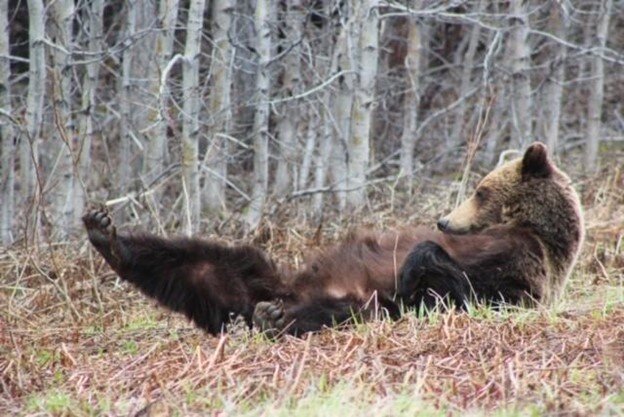The Bare Facts About Bears
Grizzly enjoying a nap beside the highway. Note the distinctive hump on its back. Photo taken by me.
We get out-and-about every chance we get. Rain, shine or snow and we are out exploring. Now that camping season has officially started, with the opening of the Territorial Campgrounds on April 30, 2021- the earliest opening ever, we are able to travel further and wider…or should that be wilder! One of the things people ask or comment on about our adventures are “aren’t bears an issue?”. We always practice being bear-aware and have so-far only seen bears from a safe distance or while in our vehicle. We don’t intentionally seek out bears, but it seems we always see at least one during our travels. An important thing to remember is that you don’t have to be far from the city centre to see wildlife- there is a reason they call Whitehorse The Wilderness City. With bears living throughout the trail systems, Miles Canyon is often one of the first places to see local bears and it’s also a tourist hot spot. As a tourist or local, it’s easy to forget you are in their home. Here are a few facts to help you distinguish the two commonly seen bears and some resources to help you stay safe in bear-country.
American Black Bear (Ursus americanus)
So their name says they are black, but in reality they range in colours from different shades of blacks, browns and even can be white! They are smaller than a grizzly and can weigh up to 400 lbs! Pretty impressive for an animal that tends to feed mainly on grasses, roots, herbs, fruit, insects and the occasional fish or other find. Even though these magnificent mammals appear to be a bit pudgy- do not let their figure fool you. American black bears can run up to 40 km/h and have the perfect claws that make them expert tree climbers. Lately, there seems to be a black bear near the entrance of the campground we are staying at, just enjoying some vegetation. Knock on wood, we have not had a negative encounter while camping.
Grizzly Bear (Ursus arctos)
With an estimated population of between six and seven thousand grizzlies in the Yukon, these gorgeous bears are on everyone’s “hope to see” list. They have an average lifespan of 20-30 years and begin reproducing around 8 years old and then only every 3-4 years. They range in colours from near black to silver-blonde and have a hump on their shoulders that helps make them more distinct from their relative, the American black bear. When looking at bear prints on the ground, grizzly prints will have nail marks showing as they have much longer claws, unlike the expert climbing American black bears. Grizzlies enjoy munching on roots, berries, grasses, sedges, horsetails, moose, caribou and small mammals. It’s surprising how easy a fully grown grizzly can hide in the low-rise bushes. We were driving through the Haines Pass last weekend and spotted a large grizzly walking along the river to just have it disappear and reappear in the thicket. It was a good reality check for us.
Comparing the two
American Black Bear
Length - 168 cm
Weight Male - 60-226 kg
Weight Female - 40-136 kg
Habitat - Boreal Forest and Subalpine
Estimated population in the Yukon - 10, 000
Grizzly Bear
Length - 1- 2.8 m
Weight Male - 139 kg
Weight Female - 95 kg
Habitat - Boreal Forest, Mountain Alpine and Arctic Tundra
Estimated population in the Yukon - 6,000- 7,000
Similar in ways
Both bears hibernate for the long Yukon winter in dens- usually from the end of October until the end of April. This does not mean that you won’t come across them during that time frame though. This past winter season, bears were spotted well into November and were out and about by early April. Even during the middle of the winter, bears may exit their dens. Both can be seen eating plants along highways throughout the Yukon, at times. Their sense of smell is great! When hiking in thickets, try to be upwind so bears can smell your presence to prevent surprising them.
Best practices
Always follow the bear-aware protocol! Carry bear spray on you, with quick accessible access, and know how to use it. Travelling in groups and making noise while out will help prevent startling a bear. Know the signs of a bear (examples: fresh scat, prints or scratches/dug holes). Keep our wildlife wild by never feeding a bear and by storing bear attractants properly- never in your tent! Do not run when you see a bear as it may trigger a chase and you are not faster than a bear!
What to do if you encounter a bear
Unfortunately, bears are not like the cartoons depict. The way you react in an encounter will completely depend on the type of encounter you have. Inform yourself before you venture out and remember they are wild animals. Here is the Yukon government’s advice on bear encounters. Want to know you will have a safe bear encounter? Pop into the McBride Museum and visit their taxidermied animals of the Yukon exhibit to see real-life-sized bears and so much more.
These omnivores are not looking to eat you or to hunt you down. Their goal all summer long is just to fatten up for the winter- on their regular diet that does not include humans. Practicing being bear-aware can make your experience everything you had hoped it would be. Regardless of proximity to civilization, remember to be prepared. We like to play a game while out for drives- “Bear or Bush”. You would be surprised by how many times we are wrong! Enjoy your explorations, but safely.
Sources:








